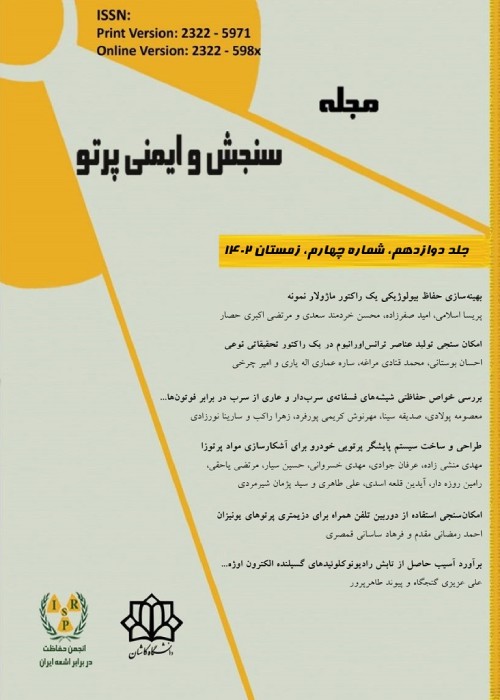Study of the 199Au nanoparticles production parameters via irradiation of platinum target by using thermal neutrons
Author(s):
Article Type:
Research/Original Article (دارای رتبه معتبر)
Abstract:
In this study, the 199Au nanoparticles production parameters have been investigated by a two-part study.The first part is about the indirect method for production of non-carrier-added (NCA) 199Au radionuclide which was investigated both theoretically and experimentally. We applied MCNPX-2.6 code, TALYS-1.9, and ALICE code, aiming to simulate the reactor core of Tehran Research Reactor (TRR) and determining the activity of 199Au by MCNPX code using cross-sections calculated by TALYS-1.9 and specifying the production yield of 199Au. Also, the excitation function of 199Au was calculated via reaction by TALYS-1.9 and ALICE/ASH-0.1 codes. As the corresponding experimental approach, we worked on the reactor production of 199Au by utilizing thermal neutron flux through irradiation of natural Pt target for a specified irradiation time of 21 hours and 10 minutes in TRR. Regarding our facilities for evaluating the production yield, two samples of 11 mg and 15.5 mg natural Pt targets were bombarded in TRR. Because the natural Pt target, consists of five different stable isotopes (192Pt, 194Pt, 195mPt, 196Pt, 198Pt), some radionuclides as impurities will be produced during the reactor bombardment. So, using an enriched Pt target will increase the production yield together with a reduction of the impurity production. To separate 199Au radionuclide from the impurities mentioned above, and also to calculate both the chemical yield and the radionuclide purity of 199Au, two chemical separation techniques were applied. In the first technique, 199Au radionuclide was separated from impurities by employing liquid-liquid extraction (LLX) using ethyl acetate. As a result of this separation, the chemical yield of 199Au radionuclide was more than 99%. In the second technique, 199Au was separated by employing LLX using liquid cation exchanger, Di-(2-Ethylhexyl) phosphoric acid (HDEHP). By applying this technique, the chemical yield of 199Au radionuclide was more than 80% consequently. We calculated the theoretical findings and compared the results with the related experimental values.In the second part of the present study, the synthesis of radioactive 199Au nanoparticles (199AuNPs) have been investigated by the Turkevich method with the aim of produce citrate-gold nanoparticles with different sizes of approximately 50 nm. Possible uses and applications of 199Au nanoparticles in medicine are also discussed.
Keywords:
Language:
Persian
Published:
Iranian Journal of Radiation Safety and Measurement, Volume:11 Issue: 4, 2023
Pages:
143 to 152
magiran.com/p2607459
دانلود و مطالعه متن این مقاله با یکی از روشهای زیر امکان پذیر است:
اشتراک شخصی
با عضویت و پرداخت آنلاین حق اشتراک یکساله به مبلغ 1,390,000ريال میتوانید 70 عنوان مطلب دانلود کنید!
اشتراک سازمانی
به کتابخانه دانشگاه یا محل کار خود پیشنهاد کنید تا اشتراک سازمانی این پایگاه را برای دسترسی نامحدود همه کاربران به متن مطالب تهیه نمایند!
توجه!
- حق عضویت دریافتی صرف حمایت از نشریات عضو و نگهداری، تکمیل و توسعه مگیران میشود.
- پرداخت حق اشتراک و دانلود مقالات اجازه بازنشر آن در سایر رسانههای چاپی و دیجیتال را به کاربر نمیدهد.
In order to view content subscription is required
Personal subscription
Subscribe magiran.com for 70 € euros via PayPal and download 70 articles during a year.
Organization subscription
Please contact us to subscribe your university or library for unlimited access!



